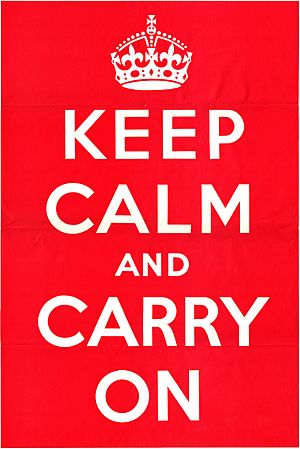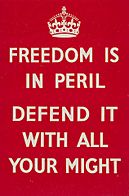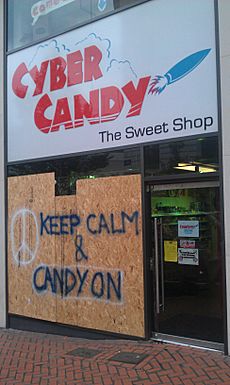Keep Calm and Carry On facts for kids
The famous poster Keep Calm and Carry On was created by the Government of the United Kingdom in 1939. This happened just before World War II began. The main goal of the poster was to help British people feel brave and hopeful. They were worried about big air attacks on their cities.
About 2.45 million copies of the poster were printed. But it was rarely seen in public. Most people didn't know about it until a copy was found in 2000. This happened at a bookshop called Barter Books in Alnwick. Since then, the poster has become very popular. Many companies now sell products with its design.
The poster reminds people of a British idea called the "stiff upper lip". This means staying calm and strong even when things are hard. It's about being disciplined and brave. At first, people thought only two original posters still existed. But in 2012, about 15 more were found. They belonged to the daughter of a former Royal Observer Corps member. More copies have been found since then.
Contents
History of the Poster
Creating the Design
The Keep Calm and Carry On poster was designed by the Ministry of Information. This government group worked on it from June to July 1939. It was one of three "Home Publicity" posters. The other two said: "Your Courage, Your Cheerfulness, Your Resolution Will Bring Us Victory" and "Freedom Is in Peril / Defend It With All Your Might".
Each poster had its slogan under a picture of a Tudor Crown. This crown was a symbol of the government. The "Keep Calm" poster was meant to be used if there were big problems during the war. For example, if cities were bombed with explosives or gas. People expected these attacks to happen very quickly once war started.
The posters were planned starting in April 1939. The final designs were approved on August 4, 1939. Printing began on August 23, 1939. This was the same day that Germany and the Soviet Union signed an important agreement. The posters were ready to be put up within 24 hours of war breaking out.
The posters came in 11 different sizes. They ranged from small (about 15 by 10 inches) to very large. The background color was either red or blue. The letters were likely drawn by hand. They look similar to certain simple, clear fonts like Gill Sans.
Making and Giving Out the Posters
Almost 2.5 million copies of Keep Calm and Carry On were printed. This happened between August 23 and September 3, 1939. However, the "Your Courage" and "Freedom is in Peril" posters were put up everywhere. The "Keep Calm" poster was not.
It was decided to keep the "Keep Calm" copies hidden away. They were meant to be used only after serious air raids. But these copies were later destroyed in April 1940. This was part of a big effort to save paper during the war.
A few copies of "Keep Calm and Carry On" did appear in public. But this was rare and not officially allowed. For example, a newspaper in October 1940 reported seeing one in a shop in Leeds. A photo from 2016 shows it on a wall in a government lab. Another photo from 1941 shows a large version in a pub.
The posters were made because people thought enemy attacks would start right away. They believed there would be a great need to calm everyone down. But the first poster campaign happened during the "Phoney War". This was a time when there wasn't much fighting. So, people hadn't yet experienced direct attacks.
The rest of the poster campaign was stopped in October 1939. This was because people complained about its cost and how well it worked. Studies showed that the public did not like the first two posters. People said "Your Courage" was too long and confusing. They also found too many posters annoying. Some even thought "Your Courage" meant ordinary people would suffer for the rich.
A design expert named Susannah Walker thinks the campaign was a "big failure". She believes it showed that government officials didn't understand how people felt. Stuart Manley suggests that the bad reaction to the first two posters caused "Keep Calm" to be held back. He thinks this was a mistake. He believes it would have been popular then, just as it is now.
Later Events
In May and June 1941, 14 million copies of a leaflet were given out. It was called "Beating the Invader". This leaflet included a message from Prime Minister Winston Churchill. The leaflet started with "If invasion comes..." It told people to "Stand Firm" and "Carry On".
These two phrases were not in the same sentence. They were for different groups of people. Civilians in fighting areas were told to "stand firm" (stay put). Those not in fighting areas were told to "carry on" (keep doing important war work). The leaflet said each command was a "great order and duty" if an invasion happened. It then listed 14 questions and answers about what to do.
Finding the Poster Again
In 2000, Stuart Manley was looking through old books. He and his wife Mary owned Barter Books in Alnwick. He found one of the original "Keep Calm and Carry On" posters. The couple framed it and put it near their cash register. Many people were interested in it. So, Stuart Manley started making and selling copies.
In late 2005, a journalist wrote about the replica posters as a Christmas gift idea. This made them even more famous. Other companies started making similar products. Soon, the design was used on many different items. Mary Manley later said she didn't want it to become too common. But she noted it had become "trivialized beyond belief."
In early 2012, Barter Books released a short film. It was called The Story of Keep Calm and Carry On. This film showed how the design became modern and commercial. The poster now represents British strength and calmness. It's seen as an inspiring message from the past for tough times today. However, this idea doesn't always remember why the poster was first made. It also doesn't remember that the original campaign wasn't very successful.
Trademark Claims
In August 2011, a UK company tried to claim the slogan "Keep Calm and Carry On" as its own. This company was called Keep Calm and Carry On Ltd. They registered it as a trademark in the EU and the United States. They had failed to register it in the UK.
The company then asked others selling "Keep Calm and Carry On" products to stop. But many people, including the Manleys from Barter Books, questioned this. They argued that the slogan was used widely before the company registered it. So, it shouldn't belong to just one company.
A request was made to cancel the trademark. The argument was that the words were too common for one person to own them. But this request was rejected. The trademark is still protected in all EU countries. The company also tried to register the slogan in the United States and Canada.
Copies and Parodies
As the poster became more popular, many copies and funny versions appeared. It became a well-known Internet meme. The new messages range from cute to political.
Some examples include:
- "Now Panic and Freak Out" (with an upside-down crown)
- "Get Excited and Make Things" (with a crown made of spanners)
- "Keep Calm and Have a Cupcake" (with a cupcake picture)
- "Don't Panic and Fake a British Accent"
- "Keep Spending and Carry On Shopping"
- "Keep Calm and Don't Sneeze" (during the 2009 swine flu pandemic)
- "Keep Calm and Call Batman" (with the Batman logo)
- "Keep Calm and Switch to Linux" (with Tux, the Linux penguin)
- "Keep Calm and Wash Your Hands"
In 2012, the band McFly had a tour called "The Keep Calm and Play Louder Tour". Their posters looked very much like the 1939 design. Also, in 2012 and 2013, a campaign to save University Hospital Lewisham used a poster. It said: "Don't Keep Calm Get Angry and Save Lewisham A&E".
The mayor of Calgary, Canada, Naheed Nenshi, helped his city after big floods in 2013. People made "Keep Calm and Nenshi On" T-shirts to raise money.
Images for kids
-
Trafalgar Square event for Charlie Hebdo shooting victims, 2015
-
Electronic sign inside a metro station in Washington, DC during the COVID-19 pandemic, 2020
See also
- British propaganda during World War II
- We Can Do It!, an American World War II poster that also became popular later.
- Live, Laugh, Love, another old motivational phrase popular on decor.










